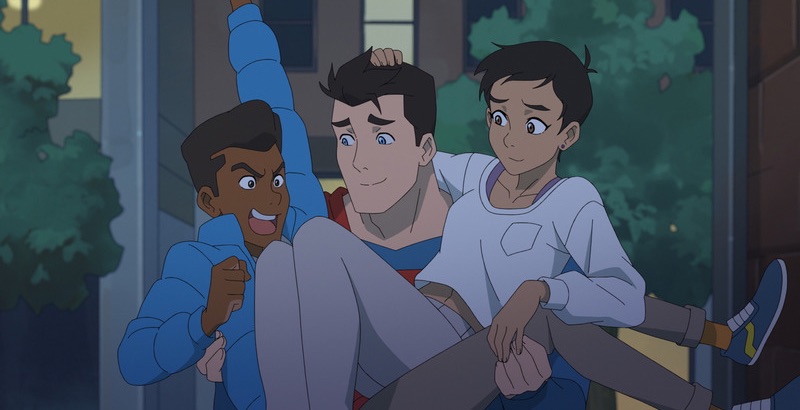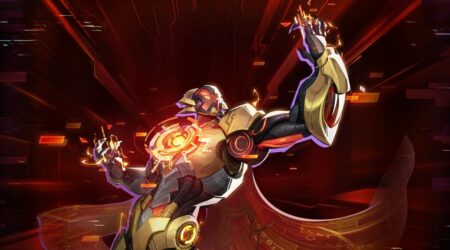For the many ups and downs that DC live-action films have faced with the often divisive results from The Flash to Zack Snyder’s Justice League, there’s one area where these heroes have always flourished. While they might not be met with the same scope of audience that the theatrical runs are met with, DC animated TV series have always been the crown jewel of DC adaptations.
As is generally the case with the best of animation, the shows expand on the limitless nature of these characters’ worlds better than live action ever could. The medium succeeds in capturing the overwhelming nature of their powers while also offering commentary on who these characters are, how they’re able to grapple with their powers, and how it allows them to, or stand apart from the rest of the world.
With the recent release of the Christmas film Merry Little Batman and the upcoming Aquaman and the Lost Kingdom, we’ve ranked the ten best DC animated TV series that have helped define the characters and their worlds.
10. Superman: The Animated Series

The second series of the official DC Animated Universe, Superman: The Animated Series sought to update a familiar, longstanding character who so often is dubbed as boring due to his near impenetrable strength. Similar to Kevin Conroy as Batman, Tim Daly too became synonymous with his character as Clark Kent/Superman. He added a layer of good-natured maturity to Superman that helped straddle the old and the new that the series was trying to balance. The series depicts a vibrant Metropolis with strong, distinctive artistry that perfectly represents the Superman character.
9. Teen Titans Go!

It’s DC for Gen Z. Born from an era of Cartoon Network where shows both super referential, hyper meta, and reliant on the growing emotional fluency of its generation of youthful viewers, Teen Titans Go! is a strong indicator of the type of shows developed by younger, fresh minds. Cut from the same cloth as a series such s Adventure Time or Over the Garden Wall, Teen Titans Go! adopts a vibrant and boldly colored story, accompanied by harsh line work that helps make the comic element of the series pop. It’s silly and ridiculous but is undoubtedly effective with its humor.
8. Static Shock

Possessing a cooler edge compared to some of its contemporaries, Static Shock has a strong fanbase due to its younger protagonist, his interesting powers, and the strong supporting cast. The series follows Virgil Hawkins who works under the name “Static.” Having developed electromagnetic powers after being exposed to a mutagen gas, his skills and abilities allow for fun animation. The writing also managed to tackle topics of social justice with depth and introspection. As the first Black superhero to lead his own show, Virgil is lovable even while facing real-world problems that often separate him from the more fantastical realms of other DC animated projects.
7. Young Justice

While the entire series is worth seeking out for DC fans, there’s no doubt it’s the first and second seasons of Young Justice that finds its formidable fan base. Initially canceled after two seasons, the series opened up the superhero roster to the sidekicks of the more iconic characters, with Robin, Kid Flash, Aqualad, Superboy, Miss Martian, and Artemis all making up the original covert operation team in the series. Despite the fantastical setting full of super-powered beings, Young Justice maintains a level of realism, from the character’s costumes to the way they act and behave like actual teenagers. The heightened emotions lead to errors and poor judgment adding to the interpersonal turmoil and stakes.
6. Harley Quinn

Bold, bloody, and gay, Harley Quinn brings the titular character to life with a brazenness that perfectly fits its leading lady. The romantic development between Harley Quinn and Poison Ivy and the former’s continued wavering between her instincts to do good or commit crimes establishes the series’ foundation. The show is further emboldened by terrific voice work and an unpredictable storyline. With some of the grossest imagery on television, the series manages its flow of carnage while simultaneously allowing for character growth as Harley tries to find herself in a city often overrun by mayhem. It’s an acidic sugar high in visual form.
5. Batman Beyond

With how often the character is brought up in popular media, it’s surprising that stories about Batman never lessen in appeal. This is especially true in animation, which is evident in series such as Batman Beyond, which puts a spin on the familiar character. The Gotham we’re introduced to is set in the near future, with teenager Terry McGinnis taking on the Batman mantle now that an elderly Bruce Wayne is effectively retired.
Acting as a sequel to Batman: The Animated Series and The New Batman Adventures, the series plays off of the established tone while also figuring out its own style and tone, better representing the teenage activities and experiences of Terry—a much different character than Bruce. Embellished with cyberpunk leanings (a marker of its time) and darker throughlines, it might not be DC’s most cohesive animated series, but it amassed a cult following regardless due to its palpable energy and fresh take on an iconic figure.
4. My Adventures with Superman

Yes, the series only came out this past year. Still, My Adventures with Superman is as strong an entry as any legacy title with a confident grasp on what distinguishes the character of Superman/Clark Kent. Developed by Jake Wyatt, Brendan Clougher, and Josie Campbell, the series follows a younger iteration of the titular character, here voiced by Jack Quaid.
Clark spends much of the ten episodes trying to be nothing more than a “normal man.” With clear anime influences from Sailor Moon and Dragon Ball Z to Ouran Host Club and even Berzerk, the series still establishes its own palette with soft lines and cool color tones that fit Superman’s strict aversion to violence or combat. Clark’s continued distress over being seen as different gives the show its emotional throughline as he tries to balance both sides of himself before reconciling the two. With an abundance of heart, the series, especially its final episodes, leaves a definitive impact.
3. Teen Titans

Adapting a visually distinct color palette that signifies its unique spin on the DC universe, Teen Titans marries the film noir aspects of Batman: The Animated Series with pulpy animation that riffs on clear anime inspiration. Featuring the characters Robin, Starfire, Cyborg, Raven, and Beast Boy, the humor has a distinctive mid-2000s angle that works well with the youthful vibe of the series that’s visually buoyant and flexible.
Faced with considerable threats, such as Slade Wilson (voiced by Ron Perlman) in Season 1 and Trigon in Season 4, the series never suggests that the stakes at play are lesser due to the Teen Titans being made up of younger characters. Instead, the stakes are further raised by the emotional volatility of adolescence. The humor never lacks, helping balance the series in its darker moments. With solid combat sequences and kinetic action, the series delivers rich stories anchored by well-developed characters.
2. Justice League / Justice League Unlimited

Originally named Justice League before a rebranding to Justice League Unlimited following its second season, nothing can top this series’s sheer scope and scale. Throughout five seasons, the show allowed space and considerable character development for some of the best-defined heroes while letting the greater DC hero roster shine as well.
That said, while there’s a joy to be had in the expansive way the series managed to highlight characters who, up until this point, had hovered under the radar, the two series found their heart in the original lineup of Batman, Superman, Wonder Woman, The Flash, Green Lantern, Hawkgirl and Martian Manhunter. The series deconstructs some of their most famous lore while allowing many of them some of their finest moments in any media adaptations. And it’s all aided by strong voice work and a more adult approach to how these key figures are treated.
While much of the series relies on a villain-of-the-week style format, it never loses its emotional pull. Episodes such as “Only A Dream” are one-shot installments but allow Batman to show off his comedic side thanks to a fun villain, while the epic, three-part series finale “Star Crossed” offers a dramatic twist of tales with secret identities revealed and significant betrayals. It might not be the most overtly stylish series on the list, but it’s one of the very best due to insightful character-driven writing that understands both where the heroes come from and how best to further illuminate and expand their stories.
1. Batman The Animated Series

Batman: The Animated Series establishes itself through its distinctive visual language that builds on the Tim Burton aesthetic of Batman and Batman Returns. Developed by Bruce Timm and Eric Radomski, the series is a layered, thematically complex story that demonstrates the artistry of animation and how it, as a medium, is just as capable of impactful storylines as live-action.
It also highlights how even television series geared towards a younger demographic can still employ thoughtful, engaging, and mature storylines without losing that initial audience. The tremendous Kevin Conroy voices the caped crusader in his first outing as Batman, becoming synonymous with the character in this series. To many of us, Conroy is our Batman. The same can be said for Mark Hamill’s performance as The Joker. The two add layers of depth to the iconic adversaries.
While the writing and voice work are both superb, the artistry best defines the series and makes it both the best DC animated series and one of the best, if not the best, animated series of all time. The combination of futuristic touches in the design, the film noir aesthetic matched with the Art Deco styling, and the pivot from industry standards so that all backgrounds would be painted using light colors on black paper—all of it culminates in an idiosyncratic piece of fiction. Gothic and overwhelming, the story’s mood is mirrored by the stylized, towering structures of Gotham, making it one of the best displays of how to utilize the language of images to represent the tonality of the story being told.
There’s no stopping the superhero run in Hollywood even as they continually dip in quality. While live-action adaptations continue to suffer, it’s worth remembering that DC has continually proven to understand its source material with terrific animated adaptations. From the early 90s to current day, there’s plenty available to explore for both comic readers and non-comic readers alike. With engaging animation and expansive stories, these shows expertly detail both the heroic exploits of their characters and showcase the personal relationships that drive them.







